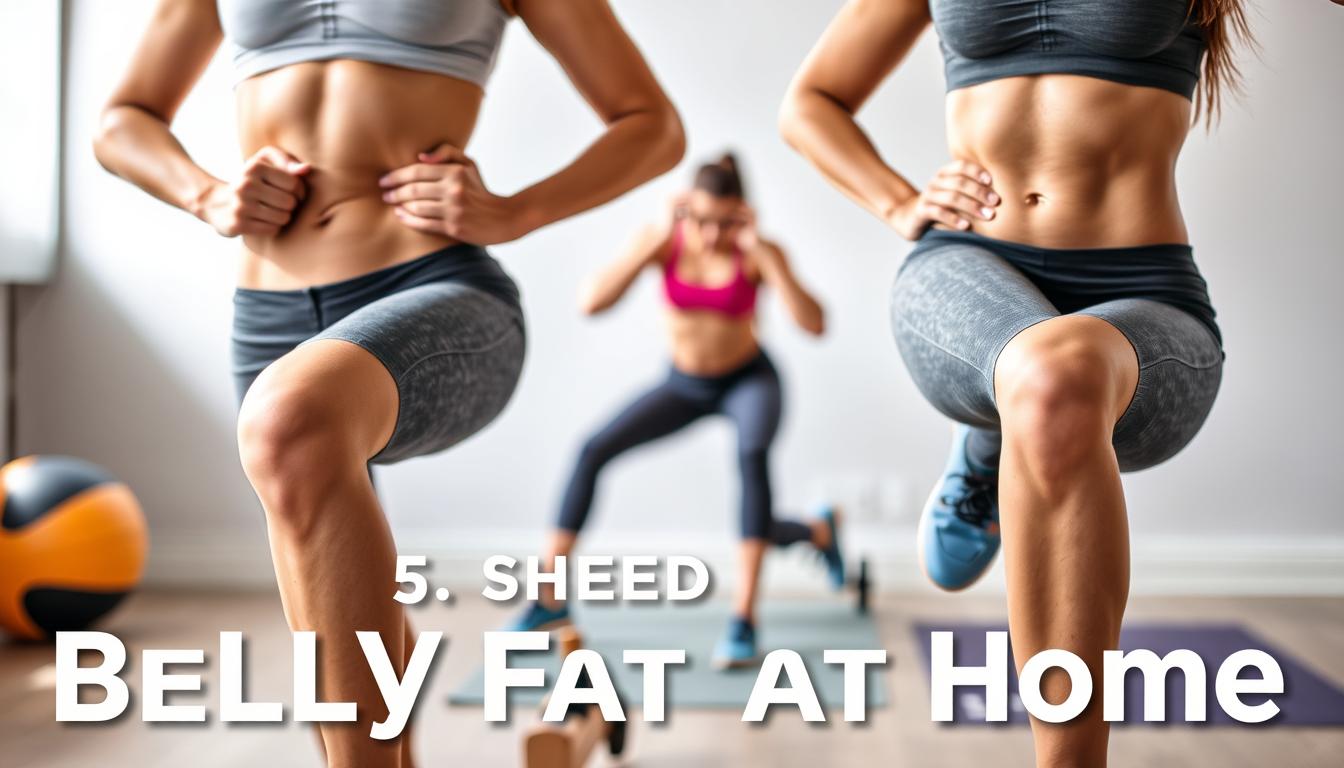Are you tired of struggling with stubborn belly fat? You’re not alone. Many people struggle to get a healthier midsection. They often feel frustrated because they can’t find good solutions. Effective belly fat loss strategies are key to better health and more confidence.
Good news: you don’t have to look far for answers. Simple, proven methods can help you reduce belly fat at home. This article will show you the best ways to reach your goals.
Key Takeaways
- Understand the importance of a healthy diet in reducing belly fat
- Learn effective exercises to target belly fat
- Discover lifestyle changes that support belly fat loss
- Explore stress management techniques for a healthier midsection
- Get tips on maintaining motivation throughout your journey
Understanding Belly Fat: Types and Health Implications
It’s important to know about the different kinds of belly fat and how they affect our health. Belly fat is more than just a beauty issue. It’s a serious health problem that needs a detailed solution.
Visceral vs. Subcutaneous Fat
Belly fat is mainly split into two kinds: visceral fat and subcutaneous fat. Visceral fat wraps around organs inside the belly. Subcutaneous fat is just under the skin. Visceral fat is more dangerous because it’s closer to important organs.

Health Risks Associated with Excess Belly Fat
Too much belly fat, mainly visceral fat, can lead to many health problems. These issues affect different parts of the body.
Cardiovascular Concerns
One big risk is to the heart. Visceral fat can raise the chance of heart disease, high blood pressure, and stroke. It does this by changing cholesterol and blood pressure levels.
Metabolic Implications
Too much belly fat also affects how our body works. It can lead to type 2 diabetes and metabolic syndrome. These conditions make it harder to manage weight and stay healthy.
Understanding belly fat and its health risks is key. Knowing the dangers of too much belly fat helps us make better choices for a healthier life.
- Visceral fat is more harmful than subcutaneous fat.
- Excess belly fat increases cardiovascular risks.
- Metabolic syndrome and type 2 diabetes are linked to visceral fat.
Assessing Your Current Situation
Before you start your belly fat loss journey, it’s key to know where you stand. This first step helps create a plan that fits you perfectly.
Measuring Belly Fat Accurately
To get a clear picture, you must measure your belly fat right. There are a few ways to do this, including:
Waist Circumference Method
Measuring your waist circumference is easy. Just use a flexible tape measure around your natural waistline.
Body Fat Percentage Calculations
Another way is to figure out your body fat percentage. You can use tools like skinfold calipers or bioelectrical impedance analysis.
| Method | Description | Accuracy Level |
|---|---|---|
| Waist Circumference | Measuring around the natural waistline | High |
| Body Fat Percentage | Calculating fat percentage using various tools | Very High |
Setting Realistic Goals
After measuring your belly fat, it’s time to set realistic goals. This means:
Short-term Milestones
Setting achievable short-term goals keeps you motivated. For instance, aiming to lose 1-2 pounds a week is a good start.
Long-term Objectives
Your long-term goals should match your health aims. This might be reducing your waist by a certain amount in a few months.

The Science Behind Effective Belly Fat Loss
Getting a flatter stomach starts with knowing how your body stores and loses belly fat. You must understand the science behind fat metabolism to lose belly fat effectively.
Why Spot Reduction Doesn’t Work
Many think spot reduction is real. They believe exercising a specific area can lose fat there. But, studies prove fat loss happens all over, not just in one spot.
The Role of Hormones in Fat Storage
Hormones like insulin and cortisol are key in fat storage and use. Knowing how they work can help you control belly fat better.
Insulin Sensitivity
Insulin sensitivity is vital for using glucose. When you’re sensitive to insulin, your body handles blood sugar well. This means less fat stored around your belly.
Cortisol Impact
Cortisol, the stress hormone, affects belly fat storage. High cortisol from stress can make you store more fat around your belly.
Caloric Deficit Fundamentals
Creating a caloric deficit is essential for losing belly fat. This means eating fewer calories than you burn. A balanced diet and exercise are key to losing belly fat.
Nutrition Strategies That Target Belly Fat
A good nutrition plan can really help cut down belly fat. Focus on the right foods and eating habits. This way, you can target and reduce abdominal fat effectively.
Foods That Fight Abdominal Fat
Adding certain foods to your diet can fight belly fat. Protein-rich foods are great because they build muscle and boost your metabolism.
Protein-Rich Options
Eat lean meats like chicken and turkey, fish like salmon, and legumes like lentils and chickpeas. These foods give you protein and important nutrients.
Fiber-Filled Choices
Fiber-rich foods like whole grains, fruits, and veggies make you feel full longer. This reduces overeating. Try apples, broccoli, and quinoa.
Foods to Avoid
Knowing what not to eat is just as key. Some foods can cause inflammation and add to belly fat.
Hidden Sugar Sources
Watch out for hidden sugars in processed foods, sugary drinks, and baked goods. They can cause insulin resistance and fat storage around your belly.
Inflammatory Triggers
Inflammatory foods like processed meats, refined carbs, and fried foods can make belly fat worse. Choose anti-inflammatory foods like berries, green tea, and fatty fish instead.
Meal Timing and Portion Control
When and how you eat matters a lot. Portion control and being mindful of meal timing can greatly help in losing belly fat.
Intermittent Fasting Approaches
Intermittent fasting is effective in reducing belly fat. Try the 16:8 or 5:2 diet to regulate your metabolism and improve fat burning.
By using these nutrition strategies, you can make a solid plan to target belly fat.
Effective Home Exercises for Belly Fat Reduction
Reducing belly fat at home is possible with the right exercises. Start by adding core-strengthening, High-Intensity Interval Training (HIIT), and low-impact cardio to your routine. You’ll see results soon.
Core-Strengthening Exercises
Core exercises are key for burning belly fat and boosting core stability. They work your abdomen, back, and pelvis muscles.
Beginner-Friendly Routines
- Plank: Hold a plank for 30-60 seconds to work your core.
- Crunches: Do 15-20 crunches to target your abs.
- Leg Raises: Perform 3 sets of 10-15 leg raises for lower abs.
Advanced Core Workouts
- Russian twists: Do 3 sets of 20 twists on each side for obliques.
- Bicycle crunches: Complete 3 sets of 15-20 bicycle crunches for a full core workout.
- Side plank: Hold a side plank for 30-60 seconds on each side to boost balance and core strength.
High-Intensity Interval Training (HIIT)
HIIT is short, intense exercise followed by brief rest. It’s great for burning belly fat.
10-Minute HIIT Workouts
- Burpees: Do 3 sets of 10 burpees with 30 seconds rest in between.
- Jumping jacks: Perform 3 sets of 30 seconds of jumping jacks with 15 seconds rest.
- Mountain climbers: Do 3 sets of 30 seconds of mountain climbers with 15 seconds rest.
Equipment-Free Options
You can do HIIT without equipment. Try squat jumps, push-ups, and lunges.
Low-Impact Cardio Options
Low-impact cardio is easy on your joints and can be done at home. It’s perfect for beginners or those with mobility issues.
Walking Programs
- Brisk walking: Aim for at least 30 minutes of brisk walking daily.
- Walking lunges: Do 3 sets of 10 walking lunges to work your legs and glutes.
Home-Based Aerobic Routines
- Dancing: Follow a 30-minute dance workout video at home.
- Jump rope: Do 3 sets of 30 seconds of jump rope with 15 seconds rest.
Lose Belly Fat at Home: What Actually Works and What Doesn’t
When trying to lose belly fat, it’s key to pick methods backed by science. There are many ways to try, but knowing what works and what doesn’t is important. This can really help you succeed.
Debunking Common Myths
Many products and methods promise quick belly fat loss, but not all are true. For example, some ab machines and gadgets claim to tone your abs easily.
Ab Machines and Gadgets
These devices can strengthen your core a bit, but they’re not enough on their own. Using only these gadgets can be very disappointing.
“Miracle” Supplements
Also, “miracle” supplements that promise to melt belly fat often don’t work and can be dangerous. Always talk to a doctor before taking any new supplements.
Evidence-Based Approaches
So, what does actually work? Studies show that a healthy diet, regular exercise, and staying consistent are the best ways.
Consistency Over Intensity
It’s not about being super intense with your workouts. Being consistent with moderate exercise is better in the long run.
Combined Diet and Exercise Effects
Eating well and exercising regularly not only burns fat but also boosts your health. Choose whole foods, lean proteins, and lots of veggies.
Realistic Timeframes for Results
Remember, losing belly fat takes time. Setting achievable goals and celebrating small wins keeps you motivated. Losing 1-2 pounds a week is a safe and healthy pace.
By sticking to proven methods and avoiding scams, you can get a slimmer waist. Stay dedicated, and you’ll see changes over time.
Stress Management Techniques for Weight Loss
Stress can make it hard to lose weight, mainly around the belly. But, there are ways to fight its effects. When stressed, your body makes cortisol, a hormone that helps fat build up around your waist.
The Cortisol-Belly Fat Connection
Cortisol is key in storing belly fat. High cortisol from constant stress can cause more fat to gather around your belly. Knowing this is important for a good weight loss plan.
Practical Stress Reduction Methods
Lowering stress is key to losing belly fat. Two good ways are breathing exercises and mindfulness practices.
Breathing Exercises
Deep breathing exercises calm your mind and cut down cortisol. Doing them often can improve how you handle stress.
Mindfulness Practices
Mindfulness, like meditation, lowers stress overall. It helps you deal with stress better and live healthier.
The Importance of Quality Sleep
Sleep is key to losing belly fat and feeling good. While diet and exercise are important, sleep is just as vital. It helps control hormones, metabolism, and weight.
How Poor Sleep Affects Weight Gain
Poor sleep can make it hard to lose belly fat. Without enough sleep, your body makes more cortisol, a fat-storing hormone. It also makes you hungrier and less full, making healthy eating tough.
Strategies for Better Sleep
To sleep better, make your bedroom cozy and follow calming pre-sleep routines. These routines tell your body it’s time to sleep.
Bedroom Environment Optimization
Make your bedroom dark, quiet, and cool. Use curtains, earplugs, or a white noise machine if needed. Choose a comfy mattress and pillows for a good night’s sleep.
Pre-Sleep Routines
Start winding down with a pre-sleep routine. Try reading, taking a warm bath, or deep breathing. Stay away from screens an hour before bed to avoid disrupting your sleep hormone.
| Sleep Improvement Strategy | Benefits |
|---|---|
| Optimize Bedroom Environment | Enhances sleep quality, promotes deeper sleep |
| Establish Pre-Sleep Routine | Signals body to wind down, improves sleep onset |
| Avoid Pre-Bedtime Screens | Reduces blue light exposure, supports melatonin production |
Common Mistakes to Avoid in Your Belly Fat Loss Journey
Many people find it hard to lose belly fat because of mistakes in their diet and exercise. Knowing these common mistakes is key to a successful weight loss journey.
Overtraining and Recovery Issues
Too much training can actually harm you, leading to injuries and burnout. It’s important to have enough rest time for your muscles to heal. Make sure you balance your workouts with enough downtime.
Diet Pitfalls and Misconceptions
Your diet is very important for losing belly fat. Stay away from diet pitfalls like eating too few calories, which can slow down your metabolism. Eat a balanced diet with whole foods, lean proteins, and healthy fats.
Inconsistency and Program Hopping
Inconsistency is a big problem for losing belly fat. Changing your diet or workout plan too often can slow down your progress. Stick to a solid plan and only make changes if you need to.
Avoiding these common mistakes can help you lose belly fat more effectively. This way, you can reach a healthier weight in a sustainable way.
Creating a Sustainable Belly Fat Loss Routine
A well-planned routine is key to losing belly fat. Focus on making lasting changes, not quick fixes.
Building Healthy Habits
Healthy habits are the base of a good belly fat loss plan. It’s about making smart choices in diet and exercise.
Daily Action Steps
Start with daily steps to build habits. This could be:
- Drinking at least 8 glasses of water per day
- Eating a balanced diet with fruits, veggies, and lean proteins
- Doing physical activity, like a 30-minute brisk walk
Weekly Planning Strategies
Weekly planning helps keep you on track. Plan meals, workouts, and set weekly goals.
Overcoming Plateaus
Plateaus are common in weight loss. To beat them, review and adjust your routine.
Progressive Overload Principles
Progressive overload means increasing workout intensity. You can do this by:
- Lifting heavier weights
- Adding more reps or sets
- Reducing rest time between exercises
Diet Adjustments When Progress Stalls
If progress slows, diet changes might be needed. Try eating fewer calories or adjusting macronutrients.
| Diet Adjustment | Potential Benefit |
|---|---|
| Reducing Caloric Intake | Creates a caloric deficit, promoting weight loss |
| Changing Macronutrient Ratios | Can improve metabolic health and support fat loss |
Maintaining Motivation Long-Term
Keeping motivated is vital for long-term success. Find a workout buddy, track your progress, and celebrate milestones.
“The key to success is to focus on the journey, not just the destination.”
Tracking Progress Beyond the Scale
Looking beyond the scale can reveal a lot about your progress. While regular weigh-ins are helpful, they’re just part of the story. To truly understand your journey, consider other factors.
Alternative Measurement Methods
There are many ways to measure your progress. These methods offer a clearer view of your journey to losing belly fat.
Progress Photos
Progress photos are a powerful tool. They show visual changes in your body. By comparing photos, you can see your progress, even if the scale doesn’t show it.
Clothing Fit Tests
Clothing fit tests are another effective method. As you lose fat, your clothes will fit differently. Watching how your clothes fit can motivate you to track your progress.
Non-Physical Indicators of Success
Success isn’t just about physical changes. There are non-physical indicators that show you’re on the right path.
Energy Levels
Improved energy levels are a key indicator. As you get healthier, you’ll likely have more energy all day.
Mood and Mental Clarity
Also, many people notice better mood and mental clarity as they get fitter. This is just as important as physical changes.
Conclusion: Your Path to a Healthier Midsection
Starting a journey to lose belly fat at home needs a mix of good nutrition, regular exercise, stress control, and enough sleep. Knowing the different types of belly fat helps you understand your situation better. Aiming for a caloric deficit through diet and exercise is key for losing fat.
Core exercises, high-intensity workouts, and low-impact cardio are great for your goals. Stress management and quality sleep also play big roles in your weight loss. Avoiding common pitfalls and tracking your progress helps keep you motivated.
Stick to these strategies and keep a consistent routine to start your journey to a healthier midsection. Focus on building lasting habits, overcoming challenges, and celebrating all your successes. This way, you’ll see lasting results.


